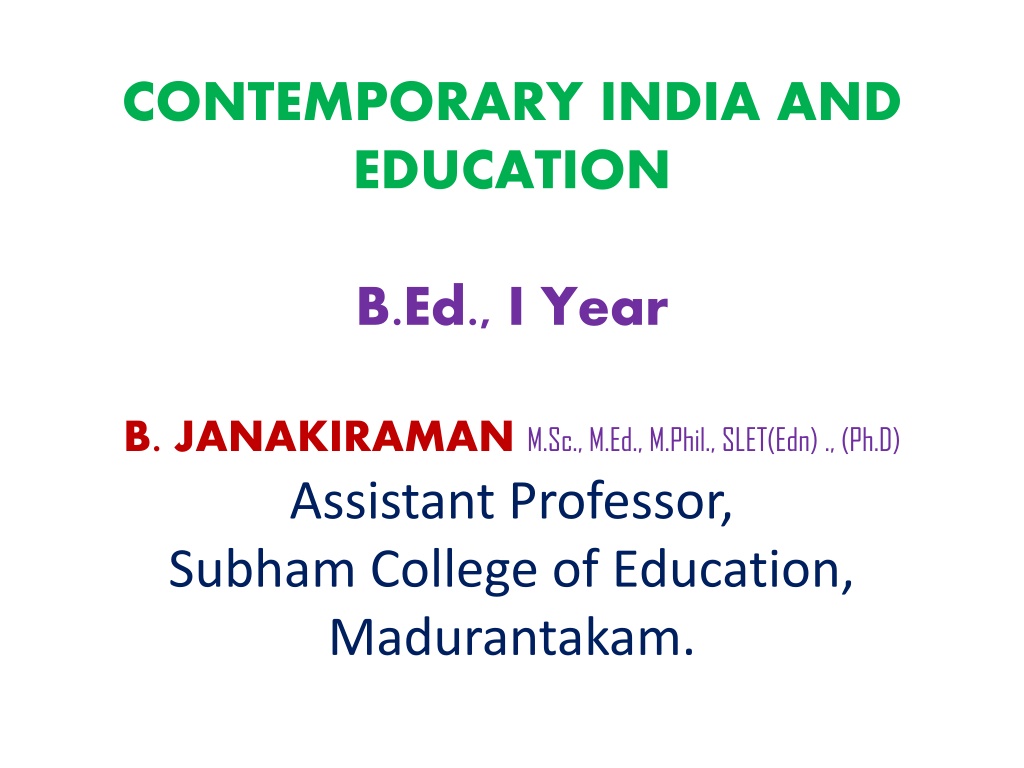Vedic Education System in Contemporary India: A Historical Overview
Explore the roots of education in pre-independent India, focusing on the Vedic system with its objectives, curriculum, and Gurukula education model. Learn about the teacher-student relationship and the central role of the teacher in shaping learners' lives. Discover the spiritual and intellectual development goals, emphasizing not just book learning but also character and cultural preservation.
- Vedic education
- Gurukula system
- Pre-independent India
- Teacher-student relationship
- Educational history
Download Presentation

Please find below an Image/Link to download the presentation.
The content on the website is provided AS IS for your information and personal use only. It may not be sold, licensed, or shared on other websites without obtaining consent from the author. Download presentation by click this link. If you encounter any issues during the download, it is possible that the publisher has removed the file from their server.
E N D
Presentation Transcript
CONTEMPORARY INDIA AND EDUCATION B.Ed., I Year B. JANAKIRAMAN M.Sc., M.Ed., M.Phil., SLET(Edn) ., (Ph.D) Assistant Professor, Subham College of Education, Madurantakam.
Policy Frameworks on Education: Pre- Independent India 1.Vedic System of Education 2.Buddhist System of Education
Objectives of Vedic Education Physical and Intellectual development Teacher Centered Religious and Spiritual Knowledge the third eye Not Merely book learning Preservation and Spread of Culture Development of Character and Personality
Vedic System of Education Vedas are known as Sruthi . Sruthi means those which are directly heard and they are divine revelations. The term Veda means Knowledge or Wisdom Basic Vedas : There are four Types, 1. Rig Veda 2. Yajur Veda 3. Sama Veda 4. Atharvana Veda
Vedanthic Education 1. Aims of Education The spiritual personality is the central core of the Vedantha Philosophy. In education we have to Respect the individual personality as the object of transformation. Education should help pupils for their self-realisation. Development of personality. 2. Curriculum The Vedic curriculum consisted of the learning of Vedas, Upanishads, Siksha, Kalpa, Vyakarna, Niraktha, Chanda and Jyothisha. Study of classics like Ramayana and Mahabaratha.
Vedanthic Education 3. Gurukula System of Education Children had to spend their students days, called Brahmacharya at the residence of the Guru called Ashram , which were generally located on the outskirts of towns. All facilities like free food, clothes and stay were provided in the Ashram. 4.Method of Teaching Saravana- Listening of text Manana- Reflection on their meaning Nididyasana- Meditation as the methods to master knowledge.
Teacher students relationship Every student was required to serve his teacher compulsorily. The students obeyed the guru, any violation of Guru s instructions give punishment. Guru had full autonomy. Teacher centered Education. Lecture method is used. Sanskrit language used.
Role of Teacher Teacher influenced the learner through his life method. Teacher was considered as the spiritual father of the students. Teachers are higher calibers. Teacher possessed high moral character.
Discipline in Vedic system Students were promoted to maintain self discipline through life. Punishment were given for indiscipline. Schedule were maintained to reduce the incidence of interpersonal conflicts and indiscipline. Compulsory Brahmacharya.
Merits of Vedic Education 1. Education was free for all Eligible learners. 2. Teaching-learning process took place in natural surrounding. 3. Pupils lived in a simple and pure life of Brahmacharya. 4. Teachers commanded high respect and dignity from all the sections of the society. 5. All pupils were treated alike irrespective of their social status.
Demerits of Vedic Education Education was provided only to Brahmins, Kshatriyas and Vaisyas and denied to Sudhras. Women Education was not given any importance. Medium of instruction was Sanskrit. Some considered the service rendered by pupils in the household activities of the teacher, as slavery. Vedas were given undue importance in the curriculum.
Buddhist system of Education Bhudhhism , the religion founded by Lord Buddha, who was born in India in the 6thCentury B.C. The three works are Suttas (utterances) Vinaya (rules of discipline) Abhidhamma (Philosophical discussion)
The Teachings of Buddha The four Noble Truths There is suffering There is a cause of suffering There is cessation of suffering There is a way leading to cessation of suffering (NIRVANA)
PRINCIPLES OF BUDDHISM Paphajja Ceremony Duration - 12 Years Dress- Yellow Cloths Language- Palli Eight fold path of NIRVANA Right Faith, Resolve, Action, Living, Speech, effort, Thinking, Concentration
Aims of Education Development of Personality Physical and Intellectual development Religious and Spiritual development Character building Promotion of social efficiency and happiness Presentation of spread of culture
Aims of Education Development of Personality. The goal of Buddhist education is to attain wisdom. Physical and Intellectual development. Religious and Spiritual development. Character building. Promotion of social efficiency and happiness. Presentation of spread of culture.
Curriculum The curriculum was spiritual in nature. The aim of Education was to attain salvation. In primary Education 3 R s ( Reading, Writing and Arithmetic) were taught. In higher education religion, philosophy, ayurveda, military training etc., were included. Everyone was free to choose his subject without any restriction.
Methods of Teaching The Core of Buddha s teaching contains three major points, Discipline Meditation and Wisdom- Wisdom is the goal and deep meditation or concentration in the crucial process toward achieving wisdom.
Discipline Discipline through observing the precepts, is the method that helps one to achieve deep meditation; wisdom will then be realized naturally.
Merits 1. Students were admitted for education without any discrimination of sex and caste. 2. Vedas and rituals were denied. 3. Subjects of human utility like medicine, painting, sculpture, Mathematics and astronomy were given importance. 4. People s language of Palli was employed as medium of instruction. 5. Universities were established for higher education. 6. Budhha Bikshus were the teachers. 7. Righteous conduct and pure life were stressed.
References 1. Bhushan, Ritu, Indian History(Ancient Indian History) volume 1,shree publishers & Distributers, New Delhi,2010,P.52. 2.Nagarajan K (2009),Education in the Emerging Indian Society, Ram Publication, Chennai. 3.Periannan (2016),Contemporary India and Education, Vanitha Pathippagam,Chennai. 4. http://www.accesstoinsight.org/tipitaka/dn/dn.31.0.nara.html 5. http://www.archive.mu.ac.in,op.cit.
























